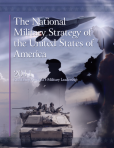 Sure, they call it the National Military Strategy of the United States of America. It’s a smart but eye-glazing document that oozes national-security platitudes on every one of its 21 pages:
Sure, they call it the National Military Strategy of the United States of America. It’s a smart but eye-glazing document that oozes national-security platitudes on every one of its 21 pages:
The United States remains the world’s preeminent power, even as a growing number of state and non-state actors exhibit consequential influence. This changing distribution of power indicates evolution to a “multi-nodal” world characterized more by shifting, interest-driven coalitions based on diplomatic, military, and economic power, than by rigid security competition between opposing blocs. There are global and regional powers exhibiting nationalism and assertiveness that tests our partners’ resilience and U.S. leadership. There exist in Asia two rising global powers and a large number of consequential regional powers. The Middle East features a number of emerging and influential regional powers. Dynamics in Asia and the Middle East, in particular, may challenge regional stability.
You can’t argue, really, with anything in the document, issued Tuesday under the signature of Adm. Mike Mullen, chairman of the Joint Chiefs of Staff. But let’s, just for sport.
Its four pillars are:
— Counter Violent Extremism
— Deter and Defeat Aggression
— Strengthen International and Regional Security
— Shape the Future Force
That’s quite a wish list. It adds that the military must “provide the full range of capabilities necessary to fulfill this strategy.” But it’s kind of like those all-you-can-eat buffets. No Waldorf salad or grated cheese seems off the table. The mission roster — supposed to force the military services to decide where to focus their firepower — is so inclusive that most any strategy or weapon system can be justified. When you choose everything, you chose nothing.
And the Soviet Union has been replaced by a new foe at the top of the Strategic Environment section:
Demographic Trends – The world will become more populated and urbanized. Global population will increase by approximately 1.2 billion and there will be more than a billion new urban dwellers by 2025. Most population growth will occur in the developing world. Conversely, in Europe and parts of Asia, populations are projected to decline and age with long term impacts to the global share of their economic output. Population growth and urbanization in the Middle East, Africa, and South Central Asia will contribute to increased water scarcity and may present governance challenges. The uncertain impact of global climate change combined with increased population centers in or near coastal environments may challenge the ability of weak or developing states to respond to natural disasters.
Maybe next time they’ll add gravity to the list.


